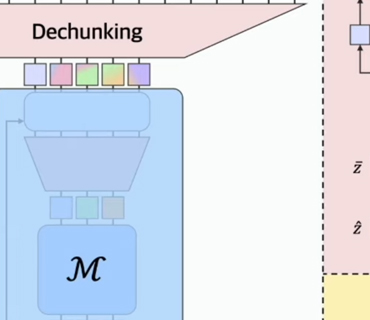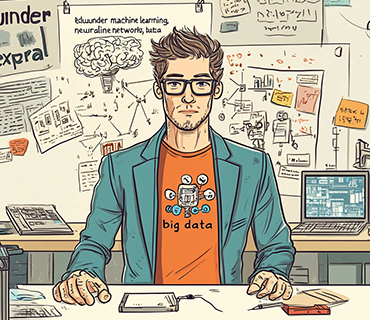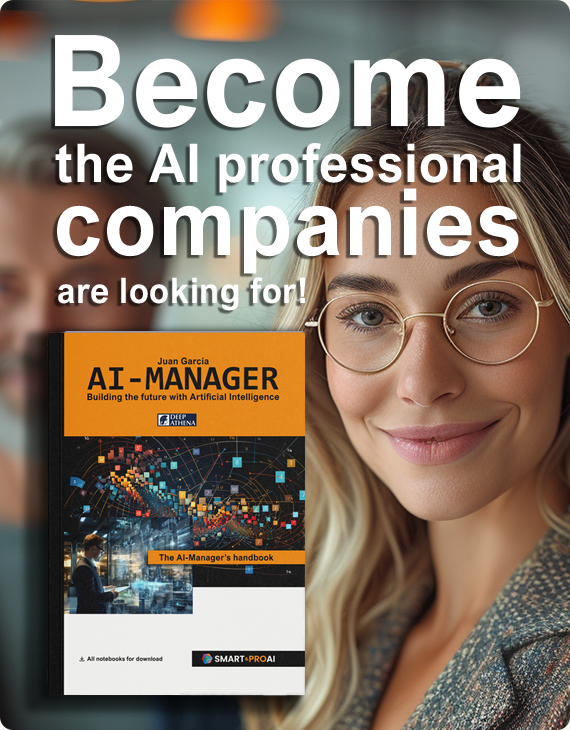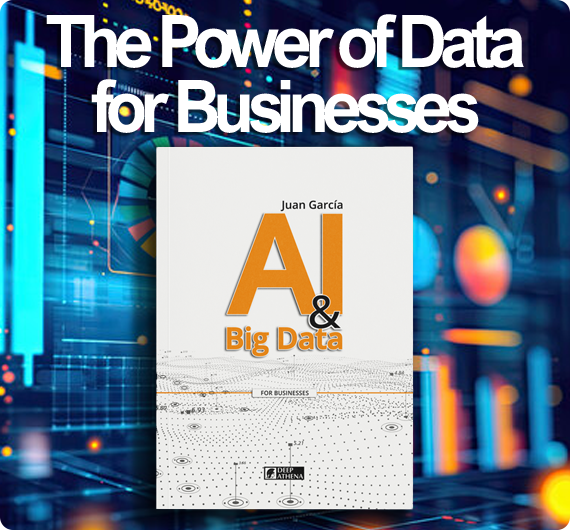Articles

Artificial Intelligence and the Human: Goodness and Evil
Introduction
Those who know me understand that I am a man of science, numbers, and statistics. I love mathematics because it doesn't lie. I advocate for AI because life and history have shown me that AI has far more potential to do good than humans do.
History repeats itself…
It always does!
Sooner or later, it does…
Religions, beliefs, mentalities, political positions, ignorance, illiteracy, propaganda, censorship… It always repeats itself!
Artificial intelligence is sweeping through our lives in a way no other technology or discovery has ever done. Although it's a concept that has been in development since the mid-20th century, it is in the last two decades that we have witnessed exponential advancements in its capabilities and applications. This phenomenon is largely due to the convergence of large volumes of data with the advent of “Big Brother,” significant advances in computational hardware, and the development of deep learning algorithms that enable machines to learn and improve from experience, “Learning by Doing.”
AI is not only limited to automating routine and repetitive tasks; its reach extends much further, encompassing precise medical diagnostics to AI-controlled vehicles. However, it is more popularly known for its generative capabilities, such as creating images, text, and the now very trendy video and audio, though the latter has been widely implemented in our lives with IoT devices like our mobile phones and assistants like Alexa or Siri. Yet now, along with these advances, come crucial questions about ethics, privacy, and security. How should we manage the immense amount of data that AI needs to function? What happens when an AI makes decisions that affect human lives? How do we prevent the malicious use of these technologies?
History shows us that each significant technological advance has brought a mix of enthusiasm and concern. The Industrial Revolution, for example, brought unprecedented economic progress but also led to deplorable working conditions and deep inequality. Similarly, the digital age has facilitated global communication and access to information but has also posed challenges such as loss of privacy and the spread of misinformation, which is the worst of all!
In this context, AI presents itself as a powerful tool that can amplify both our capabilities and our flaws. On the one hand, it has the potential to solve complex problems, optimize processes, and improve the quality of life for millions of people. On the other hand, its implementation without proper ethical guidance can exacerbate existing inequalities, perpetuate biases, and create new conflicts.
The aim of this article is to explore the duality of AI in relation to human nature. Artificial intelligence can act as a mirror reflecting both the best and the worst of us. By understanding and recognizing these aspects, we can take steps to ensure that AI is developed and used in ways that benefit humanity as a whole. To achieve this, it is essential that everyone, not just technology experts, have a basic understanding of what AI is, how it works, and what its ethical and social implications are. This is a daily matter for me as an AI expert, business advisor, AI Project Manager, and also as a trainer of professionals and educator, dealing daily with the aspects that this important advancement brings to our society.
It is important to highlight that AI is not an autonomous and independent entity. Every algorithm, application, and AI system is the result of human decisions. These decisions range from data selection and model design to the definition of objectives and real-world implementation. Therefore, the responsibility for its impact lies with us, the human beings.
With this article, I want to examine how human history offers valuable lessons about the risks and opportunities that accompany major technological changes. I also want to discuss the need for a proactive approach to educate and inform society about AI, promoting citizen participation and the development of policies that ensure ethical and beneficial use of these technologies.
This analysis aims to establish a framework to understand both the dangers and opportunities it presents. By fostering greater understanding and awareness about AI, we can work together to ensure its development contributes to global well-being, avoiding repeating past mistakes and building a fairer and more equitable future.
History Repeats Itself
Human history is full of patterns and cycles that repeat. One of the most recognized axioms in the study of history is that those who do not learn from it are doomed to repeat it. This observation, attributed to George Santayana, has proven sadly true in numerous contexts. Over the centuries, we have seen how the same mistakes, driven by ignorance, fear, and excessive ambition, have led to devastating conflicts and the perpetuation of inequality and injustice.
One of the most evident examples of history repeating itself is the cycle of wars and armed conflicts. From the Punic Wars in ancient Rome to the world wars of the 20th century, and countless regional and civil conflicts in between, humanity has repeatedly demonstrated its propensity to resolve disputes through violence. Each war brings a similar narrative: a period of rising tension, a specific trigger, a phase of confrontation, and finally an attempt at reconstruction and reconciliation that rarely addresses the underlying causes of the conflict. These causes are often complex and multifaceted, including economic, territorial, religious, and political factors.
Another example is the persecution and oppression based on ethnic, religious, or ideological differences. The Spanish Inquisition, the persecutions of Jews and other groups during the Holocaust, and political purges in the Soviet Union are all manifestations of the same human tendency towards fear and intolerance. In each case, a dominant group uses its power to oppress those it considers different or threatening. This pattern not only repeats in historical terms but also manifests in the modern era through policies of discrimination and systematic violence against minorities.
The advent of new technologies has been another area where history repeats itself. Each technological revolution, from the invention of the printing press to the information age, has been met with a mix of hope and fear. The printing press, for example, facilitated the dissemination of knowledge but also enabled the spread of propaganda and censorship. Similarly, the Industrial Revolution brought significant improvements in productivity and living standards but also caused severe social problems, such as labor exploitation and environmental degradation. In each case, technology acted as a catalyst, amplifying both the virtues and vices of human society.
In the context of artificial intelligence, we can clearly see how these historical patterns are beginning to repeat. On the one hand, AI has the potential to generate enormous benefits, from medical advances to improvements in energy efficiency. However, there is also the risk that this technology will be used maliciously or irresponsibly, exacerbating existing inequalities and creating new ethical and social problems, such as deep fakes, the generation of false images, and the massive spread of disinformation through AI systems. AI algorithms can perpetuate biases and discrimination if not designed and supervised properly, and the concentration of power in the hands of a few tech companies can lead to greater economic and social inequality.
History teaches us that technological and social progress is neither linear nor inevitably positive. Every advance comes with challenges and risks that must be managed carefully and responsibly. To avoid repeating past mistakes, it is essential to approach developments in AI with a critical awareness and a commitment to ethical and justice principles. This includes fostering broad and accessible education about AI, promoting policies that ensure its equitable and responsible use, and maintaining an open and honest dialogue about its implications.
Human history is a testament to our capacity for progress and innovation, but also to our tendency to repeat mistakes. Artificial intelligence represents a new frontier in this narrative, and it is up to us to learn from past lessons to ensure its development and application benefit all of humanity. By recognizing and confronting our flaws and limitations, we can work to build a more just and sustainable future where technology is a force for the common good.
The Duality of Human Nature
The duality of human nature is a theme that has been explored by philosophers, psychologists, and sociologists for centuries. This duality refers to the coexistence of both positive and negative aspects within each individual. On one hand, humans have the capacity to show empathy, compassion, creativity, and altruism. On the other hand, they are also capable of acts of cruelty, selfishness, violence, and destructiveness. This duality not only defines our nature but also influences how we interact with the world and with technology, including artificial intelligence.
One of the most positive aspects of humanity is our capacity for empathy and compassion. Since ancient times, people have shown a tendency to care for others, help those in need, and work together for the common good. This inclination is reflected in countless acts of kindness, from caring for the sick to fighting for human rights. Empathy allows us to put ourselves in others' shoes and act in ways that benefit the community as a whole. Without this capacity, many great works of charity and social justice would not have been possible and will not be possible.
Creativity is another fundamental aspect of human nature. Throughout history, humans have demonstrated an extraordinary capacity for innovation and invention. This creativity has led to the development of technologies that have transformed our lives, from the wheel and the printing press to electricity and the internet. Creativity is not only manifested in technology but also in art, music, literature, and other forms of cultural expression. This ability to create and appreciate beauty is one of the characteristics that define us as a species.
However, along with these positive aspects, there is also a dark side to human nature. History is full of examples of cruelty and violence. From wars and genocides to individual crimes, humans have shown a disturbing capacity to inflict pain and suffering on others. This inclination towards violence can be motivated by fear, hatred, greed, or a combination of these factors, including illiteracy, misinformation, and propaganda among some of the most important factors. Acts of violence not only affect direct victims but also have long-lasting consequences for the societies in which they occur.
Selfishness is another negative aspect of human nature. Although the survival instinct can partly explain this behavior, selfishness often leads to exploitation and injustice. In the economic realm, not just in business but also personally, for example, the relentless pursuit of personal profit has led to labor exploitation, inequality, and environmental degradation. Selfishness can also manifest in everyday life, in behaviors that prioritize self-interest over the well-being of others.
Destructiveness is perhaps the most alarming aspect of human nature. Humans have the capacity to destroy not only other individuals but also their environment. History is full of examples of massive destruction, from deforestation and species extinction to pollution and climate change. This capacity for destruction is a reminder that progress and technology, if not managed properly, can have disastrous consequences.
Religion, beliefs, and politics also play a crucial role in the duality of human nature. Religions and beliefs can inspire acts of great kindness and sacrifice but can also be used to justify violence and intolerance. Politics, in turn, can be a tool for the common good, promoting justice and equality, but also a means for abuse of power and corruption. History shows that these institutions reflect the duality of human nature, acting sometimes as forces for good and other times as vehicles for evil.
This duality is very clearly manifested in relation to artificial intelligence. On the one hand, AI has the potential to amplify our positive capabilities, helping us solve complex problems and improve the quality of life for millions of people. On the other hand, it can also be used for destructive purposes, perpetuating biases and discrimination, or being used as a tool for surveillance and control. The way we design, implement, and regulate AI will inevitably reflect this duality.
It is our collective responsibility to ensure today that the future of AI reflects the best of ourselves tomorrow.
AI as a Mirror of Society
Artificial intelligence acts as a mirror of society, reflecting both our virtues and our flaws. As a human creation, AI incorporates the values, biases, and limitations of those who develop it. Through AI, we can observe an amplified representation of our capabilities and our failures, allowing us to deeply analyze our own nature and how our decisions and behaviors impact the world around us.
One of the most evident ways AI reflects society is through the data it is fed. AI algorithms are trained using large volumes of data collected from various sources, such as the internet, historical records, and corporate databases. These data implicitly contain the biases and inequalities present in society. For example, if an AI is trained with historical employment data that reflect gender or racial discrimination, it is likely to reproduce those same discriminatory patterns in its future predictions and decisions. This phenomenon is observed daily in the development of machine learning models and has been demonstrated in several studies that have shown how AI can perpetuate and amplify existing biases in areas such as job recruitment, criminal justice, and financial services.
Besides biases, AI can also reflect economic and social inequalities. Access to technology and AI education is unevenly distributed worldwide. Countries and communities with greater economic resources have more opportunities to develop and benefit from AI, while poorer regions may be left behind. This disparity can result in an increasing digital divide, where the benefits of AI are not distributed equitably. Instead of being a tool to reduce inequality, AI can, if not properly managed, exacerbate it. This will create an abysmal difference between countries with AI and without AI.
The ethics and values of a society are also reflected in how AI is developed and used. Decisions about which AI applications are prioritized, how they are regulated, and who has access to them are influenced by the prevailing values in a society. For example, in a society that values privacy, strict regulations on the use of personal data in AI systems are likely to be established. Conversely, in societies where surveillance and control are priorities, AI may be used to monitor and control the population invasively. A notable example is the use of facial recognition systems in some countries for mass surveillance, raising significant concerns about human rights and privacy. I don't want to talk about China…
Another aspect where AI acts as a mirror of society is in innovation and creativity. Advances in AI are driven by human curiosity and the desire to solve complex problems. AI has been used to make scientific discoveries, develop new forms of art, and improve efficiency in a wide range of industries. These achievements reflect the positive side of humanity, our ability to innovate and create solutions that improve our lives. For example, in the field of medicine, AI has been used to analyze medical images and diagnose diseases with a precision that sometimes surpasses that of human experts. I have a lot of experience and personal experiences in this field. In art, AI algorithms have been able to create original works that have been exhibited in galleries and appreciated for their creativity. This is evaluated by experts in the field.
However, AI can also reflect darker aspects of society, such as mass surveillance, information manipulation, and the creation of autonomous weapons. These uses of AI highlight ethical concerns and risks associated with technological development without adequate oversight. The manipulation of information through AI algorithms has been a particularly concerning issue in the context of social networks, where fake news and disinformation can spread rapidly, influencing public opinion and undermining trust in democratic institutions.
The relationship between AI and society is bidirectional. While AI reflects society, it also has the power to influence and change it. The decisions we make today about how to develop and use AI will have a lasting impact on the future. Therefore, it is crucial to address these challenges with an ethical vision and a deep understanding of the social implications of technology. Here I see it as very important that we take it seriously, and that, for once in our history, we remain united as a society, regardless of skin color, religious beliefs, or where we reside.
By examining how AI perpetuates or challenges our biases, inequalities, and values, we can gain a better understanding of ourselves and work towards a future where technology serves the common good. By doing so, we can harness the power of AI to build a more just, equitable, and advanced society.
The War for AI Development
The war for the development of artificial intelligence is a contemporary phenomenon that reflects the geopolitical and economic tensions of the modern world. In this context, the term war does not refer to a traditional armed conflict but to an intense competition between nations and corporations to achieve supremacy in the field of AI. This competition is driven by the belief that AI has the potential to transform entire sectors, grant significant strategic advantages, and redefine the global balance of power. This war is unfolding in such a way that even Elon Musk welcomed Republican presidential candidate Donald Trump back to "X" on Monday, August 12, 2024, in an interview that naturally sparked much discussion. Opinions aside…
One of the most evident aspects of this war is the massive investment in research and development by governments and companies. Countries like the United States, China, and the European Union have allocated billions of dollars to AI programs with the goal of leading the next wave of technological innovation. These investments not only fund the development of new technologies but also aim to attract and retain top talent in the field of AI. I believe this will be impossible in countries like Spain. Here the same thing that happens with scientists, doctors, etc., will happen. Governments are aware that AI supremacy can translate into economic, military, and diplomatic advantages.
In the United States, for example, both the public and private sectors are deeply involved in AI development. X, OpenAI, Google, etc. The Department of Defense has established specific programs to incorporate AI into its operations, seeking to improve data analysis capabilities, decision-making, and the development of autonomous weapons. By the end of 2023, they had conducted combat simulations with AI-controlled fighter jets against jets piloted by experienced human pilots, with AI winning. At the same time, tech companies like Google, Microsoft, and Amazon are at the forefront of AI innovation, developing products and services with both commercial and national security applications. In Europe, on the other hand, memes with the new Coca-Cola caps are being promoted.
China, on its part, has adopted a state strategy to become the world leader in AI by 2030. The Chinese government has launched detailed action plans that include creating specialized tech parks, promoting industry-academia collaboration, and investing in AI startups. China's strategy not only focuses on technological innovation but also on the practical application of AI in areas such as surveillance, education, and healthcare, fields in which it already has many years of advantage. The combination of state support and a dynamic economy has allowed China to close the gap with the United States and, in some cases, surpass it in certain aspects of AI research and development.
The European Union is also in the race for AI development, although with a slightly different and possibly totally erroneous approach, let's call it "censorship." The EU has prioritized creating a regulatory framework that ensures the ethical and responsible development of AI. Let's explain it this way instead of using "censorship" here. Besides investments in research, the EU is working on establishing standards and guidelines that ensure AI is used in ways that respect human rights and promote social well-being. This approach seeks to balance innovation with the protection of fundamental values, such as privacy and equality. We will see where this will lead us. To AI professionals outside Europe, of course.
The competition for AI leadership also has a strong economic component. Companies that achieve significant advances in AI can gain substantial competitive advantages, dominating emerging markets and redefining traditional industries. See the case of x-Labs, the German company that developed "Flux-1," and in just a few weeks in the market, besides "breaking it," managed to take an agreement from Midjourney to integrate its model into Elon Musk's "X" platform. AI-powered automation has the potential to improve efficiency, reduce costs, and create new business models. This has led to a frenzied race to patent new technologies, acquire promising startups, and recruit the most skilled experts. Here, we must consider that anyone with a PC can develop a machine learning model or even an AI system and enter the market to compete, and even "break it!"
However, this competition also poses significant risks. One of the biggest fears is that the race for AI supremacy could lead to the militarization of the technology. The development of autonomous weapons and AI-based defense systems could destabilize the global balance of power, increasing the risk of armed conflicts. Additionally, the lack of clear international norms on the use of AI in military contexts could lead to an arms race similar to nuclear proliferation during the Cold War.
Another major risk is that the competition for AI leadership could exacerbate global inequalities. Countries and companies leading AI development are in a position to accumulate enormous economic and technological benefits, while those unable to compete, as explained earlier, could be left behind. This could deepen existing disparities between developed and developing nations, as well as within societies, where workers displaced by automation could face significant economic challenges.
Moreover, the war for AI development raises crucial ethical and social questions. As AI becomes increasingly integrated into critical aspects of our lives, from healthcare to criminal justice, it is essential to ensure that its development and use are transparent, fair, and responsible. This requires close collaboration between governments, companies, and civil society to establish regulatory and normative frameworks that guide AI development in ways that benefit all of humanity.
The Awakening of Society
“The awakening of society” to the impact and implications of artificial intelligence is a gradual but crucial process. This awakening involves a collective awareness of how AI is transforming various aspects of our lives and the need for active participation in its development and regulation. As AI becomes an integral part of the economy, politics, and daily life, society is beginning to recognize both its opportunities and risks, driving a movement towards greater education, regulation, and ethics in its implementation. Or at least it should be happening this way.
One of the first signs of this awakening is the growing interest in AI education. As AI-based technologies become more common, from virtual assistants to recommendation systems on streaming platforms and even AI-enabled toothbrushes, people are beginning to understand the importance of knowing how these technologies work. Many universities and online learning platforms have responded to this demand by offering courses on AI, machine learning, and their practical applications. These courses are not only aimed at computer science students but also professionals from various fields who want to understand how AI can influence their industries and jobs. For example, my life has changed completely. Two years ago, I never imagined that today (08.15.2024) I would be so deeply involved in this field, both in its development, project management, and also in teaching and training.
AI education is also extending to lower educational levels. Digital literacy programs in secondary and primary schools are incorporating basic AI and coding concepts, preparing future generations for a world where AI will be ubiquitous. This early educational approach is vital to closing the knowledge gap and ensuring that everyone has the opportunity to participate in the dialogue about AI development and use. Here I would like to remember that around 2016, China started implementing AI in schools with a large project that promoted teaching quality and in which teachers and professors were heavily involved, achieving great success in the results.
Besides education, regulation and ethics are emerging as essential components of society's awakening to AI. Governments and international organizations are beginning to develop regulatory frameworks that seek to balance innovation with the protection of human rights and privacy. This is leading to diverse opinions and “splitting” our society in two. Basically, what happens politically in most countries. Yes or no, blue or red, right or left, and thus the never-ending story...
The ethical debate on AI is also gaining traction. Philosophers, scientists, and legislators are discussing fundamental questions about machine autonomy, developer responsibility, and the social impacts of AI. These discussions are influencing the creation of policies and guidelines that seek to prevent the malicious use of AI and ensure its benefits are distributed equitably. Initiatives like the Montreal Declaration for Responsible AI and the Asilomar AI Principles have emerged to promote the ethical development of these technologies.
Another aspect of the “awakening of society” is the growing demand for transparency in AI development and use. People want to know how algorithmic decisions that affect their lives are made, from loan approvals to job candidate selection. This demand for transparency is leading companies and organizations to adopt explainability practices in AI, where systems must be able to provide understandable explanations of how they reached a particular decision. This trend not only increases trust in AI but also allows users to identify and correct potential biases in systems.
Citizen participation is another key element of society's awakening. As people become more aware of the impacts of AI, they are beginning to demand a seat at the table where decisions about its development and use are made. Social movements and civil society organizations are advocating for greater inclusion in decision-making processes, ensuring that the voices of diverse groups are heard and considered. This type of participation is essential to prevent AI development from being controlled exclusively by a small group of actors with specific interests.
Finally, the awakening of society also involves a reevaluation of values and priorities. AI forces us to confront questions about what we value as a society and how we want advanced technologies to be used. Should we prioritize efficiency and convenience over privacy and fairness? How can we ensure that AI's benefits reach everyone and not just a few privileged individuals? These and other reflections are leading to greater awareness and public debate about the role of AI in our lives and how we can guide its development to reflect our collective values.
As we advance into this new technological era, it is crucial that we continue fostering an inclusive and reflective dialogue about the future of AI and its impact on our society, but not separate and distance ourselves from one another. At this moment in our history, it is paramount that we understand and accept that we must remain united and sit down to discuss with a single goal, the safe, optimal, and accessible implementation for all human beings.
The Role of Education and Information
The role of education and information in the context of AI development and implementation is fundamental to ensuring that this technology is used ethically, fairly, and beneficially for society. Education, as we should all be clear about, not only prepares individuals to work in AI-related fields but also empowers the general population to understand, evaluate, and participate in the debate about its use and regulation. Information, in turn, enables informed decision-making and the creation of policies based on facts and a deep understanding of AI's implications. Reasoned discussion leads to change, ignorance leads to war.
AI education begins in academic institutions, where fundamental knowledge and technical skills necessary to advance in this field must be developed. Universities and colleges have begun offering specific programs in AI, data science, and machine learning, preparing students for roles in research, development, and application of these technologies. These programs include courses on algorithms, data processing, AI ethics, and practical applications, providing comprehensive training that covers both technical and ethical and social aspects.
However, AI education should not be limited to traditional academic institutions. Accessibility to education is crucial to democratize knowledge and ensure that everyone has the opportunity to understand and contribute to AI development. This is vital for humanity and the society it forms in this important change. Online learning platforms like Coursera, edX, and Udacity offer courses on AI and machine learning that are accessible to a global audience. Here is a small reminder, let's call it "Product Placement"; I also offer AI courses and training (See my website smartandpro.de). These platforms allow people from different backgrounds and geographical locations to access high-quality educational resources, fostering greater inclusion in the AI field, and competition also promotes a variety of prices, helping ordinary people access a wide range of courses.
Digital literacy is another essential component of education. As AI becomes integrated into more aspects of everyday life, it is important that everyone has a basic understanding of how these technologies work and how they can impact their lives. Digital literacy programs in primary and secondary schools should include modules on AI, teaching students fundamental concepts like machine learning, algorithms, and AI ethics. These programs not only prepare students for future professional roles but also equip them to be informed and critical citizens in an increasingly digital society, and as I say, to not be "mental illiterates."
Besides formal education, information and outreach play a crucial role in creating a well-informed society about AI. Both traditional and digital media have the responsibility to report, and they should report (something they don't do), on AI developments in an accurate and accessible manner. This includes explaining how AI technologies work, what their applications are, and what the associated risks and benefits are. Well-informed and ethical journalism can help demystify AI and provide the general population with the context needed to understand debates and policy decisions related to this technology.
Information must also be transparent and accessible. Companies and organizations developing and using AI should adopt transparency practices, explaining how their systems work and how algorithmic decisions are made. Explainability in AI, where systems can provide understandable explanations of their decisions, is a growing area of interest. Transparency not only increases trust in AI but also allows users to identify and correct potential biases or errors in systems. Even with the most basic knowledge of this technology, important advances can be made in what concerns our society.
Government initiatives also play an important role in AI education and information. Governments can develop policies and programs that promote AI education, from funding research to promoting digital literacy in schools. Additionally, governments should establish regulatory frameworks that ensure information on AI's use and impact is accessible and understandable to all. For example, creating AI ethics committees that include experts from various fields can provide oversight and guidance in developing AI-related policies, but they must include scientific experts, developers, philosophers, etc., not just politicians.
Collaboration across sectors is essential to maximize the impact of AI education and information. Partnerships between universities, companies, governments, and non-profit organizations can create synergies that expand the reach and effectiveness of educational and outreach programs. These collaborations can include creating training programs for workers in industries affected by automation, organizing conferences and seminars on AI and ethics, and developing accessible educational resources for the general community.
Through collaboration and commitment to education and outreach, we can ensure that AI development is inclusive, ethical, and beneficial for all of humanity.
Lessons from the Past
Lessons from the past offer invaluable guidance for understanding and addressing the challenges posed by artificial intelligence development. Throughout history, humanity has experienced numerous technological revolutions, each of which has brought significant advances as well as unintended consequences. By analyzing these historical events, we can identify patterns and learn from past mistakes and successes to avoid repeating them in the context of AI.
The Industrial Revolution is one of the clearest examples of how a technological innovation can transform society. During the 18th and early 19th centuries, the introduction of machinery and the automation of production processes led to a spectacular increase in productivity and economic growth. However, this period, as I mentioned at the beginning of this article, was also marked by profound social and economic inequalities. Workers faced extreme working conditions, including long working hours, low wages, and dangerous environments without safety measures. The lack of regulation and labor protection resulted in widespread exploitation and suffering.
The lesson we can draw from the Industrial Revolution is the importance of anticipating and mitigating the inequalities and negative impacts that can arise with the adoption of new technologies. In the context of AI, this means implementing policies and regulations that ensure AI's benefits are distributed equitably and that workers displaced by automation receive adequate support, such as retraining and job relocation opportunities. This, from my experience as a professional and my most personal opinion, must and can be fought now, before it happens, and not when we are "in the shit." When it smells, it is already causing damage...
Another relevant historical example is the invention of the printing press by Johannes Gutenberg in the 15th century. The printing press revolutionized the dissemination of knowledge, allowing for the mass production of books and facilitating access to information. This advance was fundamental for the Renaissance and the Reformation, as it allowed for the rapid spread of ideas and knowledge. However, the printing press also enabled the spread of propaganda and disinformation, which in some cases exacerbated conflicts and social divisions. Example... World War II.
The lesson here is the need to carefully manage the dissemination of information facilitated by new technologies. In the case of AI, especially in its application in media and social networks, it is crucial to develop mechanisms to combat disinformation and ensure that access to information is accurate and truthful. This can include implementing fact-checking algorithms and promoting media literacy among the population.
The nuclear age, which began with the development of atomic energy and nuclear weapons in the 20th century, offers another important lesson. The discovery of nuclear power brought with it the promise of almost unlimited energy but also the existential risk of mass destruction. The nuclear arms race and the Cold War illustrate how the competition for technological supremacy can lead to global tensions and catastrophic risks.
In the context of AI, this lesson underscores the importance of international cooperation and regulation to prevent the malicious use of technology. AI has the potential to be used for military purposes, including the creation of autonomous weapons. It is essential to establish international agreements that limit the development and use of AI in military contexts and promote peace and global security. Moreover, international cooperation can facilitate the creation of ethical and safety standards for AI development, ensuring its implementation benefits all of humanity and not just a few.
The history of computing and the development of the internet also provides valuable lessons. Since its beginnings in the 20th century, computing and global connectivity have transformed communication, commerce, and access to knowledge. However, these advances have also brought significant challenges, such as loss of privacy, cybercrime, and the creation of digital monopolies. Technology companies that control large internet platforms have accumulated considerable power, raising concerns about power concentration and lack of competition.
For AI, it is crucial to learn from these challenges and establish frameworks that prevent excessive power concentration in the hands of a few companies. Antitrust regulation, promoting competition, and protecting privacy should be priorities in the development and implementation of AI technologies. Moreover, it is necessary to foster transparency and accountability in the use of AI to ensure that tech companies act in the best interest of society.
Finally, the recent history of biotechnology and genetic engineering offers lessons on the ethics and regulation of emerging technologies. The development of techniques like CRISPR gene editing has opened astonishing possibilities for medicine and agriculture but has also raised significant ethical dilemmas about modifying living organisms. Regulating and ethically overseeing these technologies is essential to prevent abuse and ensure they are used responsibly.
In the case of AI, as we are hopefully understanding and comprehending from the start, or so I hope, it is fundamental to establish clear ethical frameworks guiding its development and use. This includes protecting human rights, promoting justice and fairness, and preventing discrimination and bias in AI systems. The participation of a wide range of actors, including scientists, legislators, civil society organizations, and the general public, is essential to develop policies and regulations reflecting society's values and concerns.
Lessons from the past teach us that each technological revolution brings both opportunities and risks. By learning from history, we can anticipate and mitigate the negative impacts of artificial intelligence, ensuring its development benefits all of humanity. Implementing fair policies and regulations, promoting international cooperation, protecting privacy and ethics, and providing accessible education and information are crucial steps to achieve a future where AI is used responsibly and beneficially. Reflecting on the past, we can build a path forward that avoids repeating mistakes and maximizes the benefits of this powerful technology.
We must not forget the past, for it has brought us here. Those who forget the past are doomed to repeat it.
A Message of Unity and Responsibility
In an increasingly interconnected and globalized world, the advent of artificial intelligence poses significant challenges as well as extraordinary opportunities. In this context, a message of unity and responsibility becomes crucial to navigate these changing times. AI is not just an advanced technology but also a reflection of our collective decisions, aspirations, and values. To ensure that this powerful tool benefits all of humanity and not just a few, we must foster a vision of global collaboration and a strong ethic of responsibility.
Unity in the context of AI development and implementation implies cooperation among various actors, including governments, companies, academic institutions, non-governmental organizations, and ordinary citizens. The multidimensional nature of AI requires interdisciplinary and collaborative approaches. For example, the technical challenges posed by AI cannot be resolved without considering their ethical, legal, and social implications. International cooperation is essential, as AI technologies know no borders, and their impacts are felt globally. We are all in the same boat here. We are all affected by this change.
Without a common framework, countries may develop and use AI in ways that generate tensions and conflicts. Creating international agreements that promote transparency, fairness, and responsibility in AI use can prevent the misuse of technology and ensure that its benefits are distributed equitably. These agreements can also facilitate collaborative research and development, sharing knowledge and resources to advance the field more effectively and ethically.
Besides international cooperation, unity must also be fostered at the community and national levels. Decisions about AI implementation should involve a wide range of stakeholders, including those who have traditionally been excluded from these debates. Local communities, workers in sectors affected by automation, and minorities must have a voice in how AI is developed and used. This inclusivity ensures that policies and practices are fair and reflect the needs and concerns of all society.
Responsibility is the other fundamental pillar in AI development and use. Responsibility starts with developers and companies creating these technologies. They must commit to following clear ethical principles, such as fairness, transparency, and accountability. This includes designing systems that are explainable and understandable to users so they can see how decisions are made and detect potential biases or errors. This is also very important at the user level. Companies must implement ethical and social impact assessments to identify and mitigate potential risks before AI systems are deployed on a large scale.
Governments also play a crucial role in ensuring responsibility. They must create and enforce regulations that protect citizens' rights and promote the ethical use of AI. This includes establishing oversight and auditing mechanisms to monitor AI use in critical sectors like criminal justice, healthcare, and employment. Moreover, governments should promote public education and awareness about AI, ensuring citizens are informed and empowered to participate in debates about its development and use.
Responsibility does not stop with developers and governments; it also extends to users and society in general. Each individual has a responsibility to learn about AI and its implications, participate in public debates, and demand transparency and accountability from key actors. Digital literacy and continuous education are essential to empower citizens to make informed decisions and contribute to creating policies and practices reflecting collective values.
A critical aspect of responsibility is managing biases and fairness. AI systems, being trained on historical data, can perpetuate and amplify existing biases. It is the responsibility of developers and organizations to identify and correct these biases to ensure AI does not discriminate against any person or group. Implementing regular audits and involving diverse teams in AI development are necessary steps to address these challenges.
Transparency is another key component of responsibility. AI systems must be transparent in their operation and decision-making processes. This not only increases user trust but also allows effective oversight and accountability. Implementing explainability principles in AI system design is crucial to achieve this goal.
A message of unity and responsibility is essential to guide AI development and implementation. Global cooperation, the inclusion of diverse voices, and the adoption of solid ethical principles are fundamental to ensuring that AI benefits all humanity. Each of us has a role to play in this process, from developers and legislators to citizens and communities. By working together and assuming collective responsibility for our actions, we can build a future where AI is used fairly, equitably, and beneficially for all.
Final Message
History has taught us that every technological advance brings both benefits and risks, and AI is no exception. As we enter this new technological era, it is crucial to address these challenges with a clear vision and collective action.
AI, in essence, reflects the duality of human nature. It can be a powerful tool for good, amplifying our creative capacities, improving efficiency in multiple sectors, and offering solutions to complex problems. However, it can also perpetuate and amplify our flaws, such as biases and inequalities. Irresponsible or malicious use of AI can have devastating consequences, from discrimination to mass surveillance and the erosion of privacy. Therefore, it is our responsibility today to ensure that its development is guided by solid ethical principles and proper oversight.
Society's awakening to the importance of AI is a positive step, but it must be accompanied by comprehensive and accessible education for all. Digital literacy and basic knowledge about AI are fundamental for people to understand, participate, and contribute to the debate about its use and regulation. Education must be a continuous effort, preparing future developers and empowering all citizens to make informed and responsible decisions.
The war for AI development reflects the tensions and aspirations of our era. Competition between countries and corporations can drive innovation, but it is also leading to a concentration of power and resources that exacerbates inequalities. It is crucial to promote international cooperation and establish regulatory frameworks that ensure AI is developed equitably and justly. International agreements and regulations should focus on transparency, fairness, and human rights protection, avoiding the use of technology for harmful purposes.
Lessons from the past remind us that we must approach AI development with a critical and reflective vision. Each technological revolution has brought profound and often unpredictable changes. By learning from our past mistakes and successes, we can anticipate and mitigate negative impacts, ensuring AI is used for the benefit of all humanity. History offers us a map of potential dangers and opportunities that we must explore with caution and responsibility.
As we reach the end of this analysis of artificial intelligence and its relationship with humanity, it is pertinent to reflect on the direction we want to take as a society. AI is not just a technological tool; it is a reflection of our values, aspirations, and fears. Its development and application force us to confront fundamental questions about who we are and how we want our future to be.
The journey toward an AI-driven future must be guided by principles of fairness, transparency, and responsibility. Every decision we make must consider not only the immediate benefits but also the long-term implications for society and the environment. This approach requires unprecedented global collaboration, where national borders and cultural differences are not obstacles to collective progress.
As we move forward, it is crucial to remember that technology alone cannot solve human problems. Empathy, compassion, and mutual understanding are essential to ensure AI is used in ways that benefit everyone without leaving anyone behind.
The true power of AI lies in its ability to amplify the best of humanity. By adopting a conscious and reflective approach, we can ensure this technology becomes a force for good. AI can help us build a world where everyone has the opportunity to thrive, but only if we act with unity and responsibility.
For each of us, this means taking responsibility to learn about AI, actively participate in its development and use, and advocate for policies and practices that reflect our collective values. We cannot afford to be mere spectators in this process; we must be active and committed participants.
This is a crucial moment in our history, and the decisions we make today will determine the future for generations to come. By working together in a spirit of collaboration and ethics, we can ensure AI becomes a positive force for all. At the end of the day, we humans shape the destiny of our technology and ultimately our world.
The reason I have written this article is that every day I see such different opinions that lead many people, blinded by ignorance and lack of knowledge, to serious discussions where they forget respect and acceptance. The diversity in international politics, censorship, disinformation, and worst of all, indifference, will lead humanity to its own self-destruction in an unprecedented situation.
And at this point, and to conclude, here… I leave my message.
Share hobbies and perspectives, but not hate! Make friends, not hate!
Those who refuse to learn from history are doomed to repeat it. When you spend your life looking for scapegoats, you remove your own responsibility. I believe you are worth it!














The Author
Juan García
Juan García is an Artificial Intelligence Expert, Author, and Educator with over 25 years of professional experience in Industrual Businesses. He advises companies across Europe on AI Strategy and Project Implementation and is the Founder of DEEP ATHENA and SMART &PRO AI. Certified by IBM as an Advanced Machine Learning Specialist, AI Manager and Professional Trainer, Juan has written several acclaimed Books on AI, Machine Learning, Big Data, and Data Strategy. His Work focuses on making complex AI Topics accessible and practical for Professionals, Leaders, and Students alike.
More